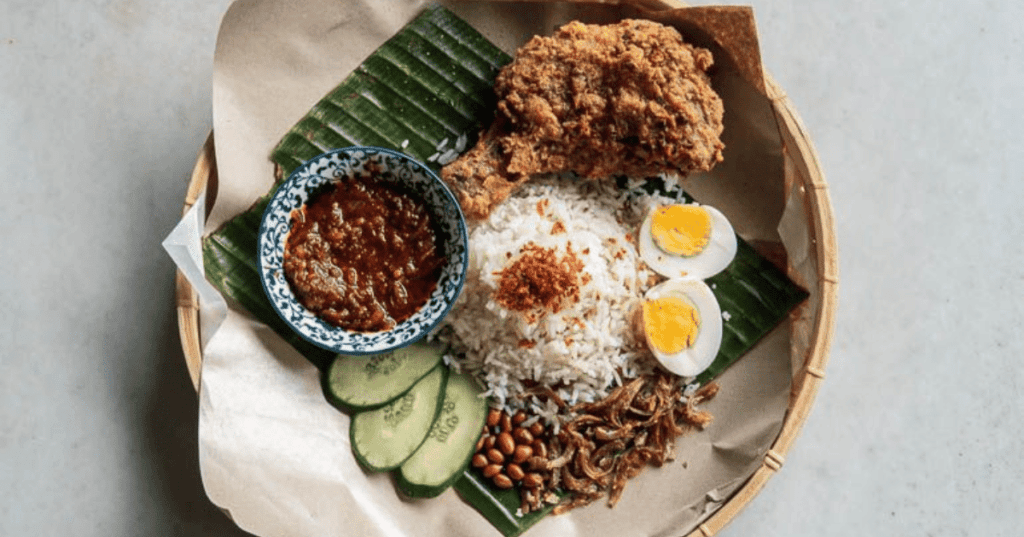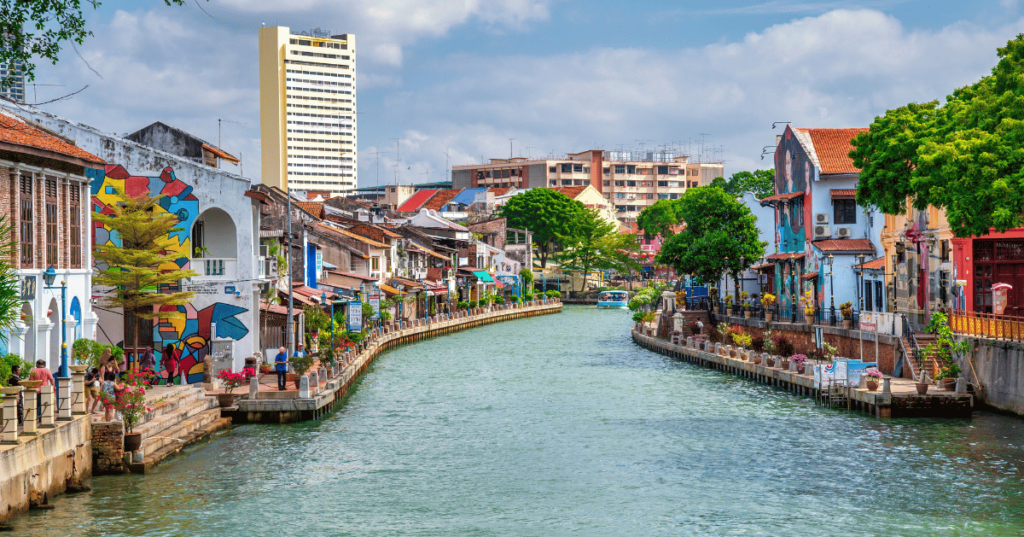Have you ever tried the Malaysian food? Well, If you love food, you’ll have a great time in Malaysia. I have made my way through Malaysia and would like to share my experiences with you. Malaysian food blends traditions to create something truly special.
Whether it’s the fiery street food in Kuala Lumpur’s street markets or the stunning plates in Penang’s beachside restaurants, Malaysian food is a source of endless pleasure and substance
This blog is all about experiencing the rich culture and history behind each dish. Whether you are a gourmand or a curious person, I will help you discover which foods to try and the best places to enjoy them. Ready to taste the best Malaysia has to offer?
Let’s get started!
What Makes the Malaysian Food Best?
Malaysia is a foodie’s dream for a few simple reasons. First, it is all about diversity. Here you have a mix of three main dishes—Malay, Chinese, and Indian. This blend produces foods you can’t find anywhere else in the world.
The ingredients are fresh. In Malaysia, chefs use local spices, herbs, and produce to add pop and flavor to each dish. Whether it’s a bowl of spicy laksa or sweet mango, freshness is key.
Besides, food can be found everywhere in Malaysia. In cities like Kuala Lumpur, you can enjoy good food at any time of the day. There are breakfast stalls open in the morning and busy night markets late into the night. You will never run out of options.
Malaysian food tells the story of the country. Every dish has a story. For example, ‘nasi lemak’ began as a peasant dish but is now a national favorite. When you dine here, you don’t just try good food—you learn about the people and their way of life.
So while roaming around Malaysia, try everything from street food to restaurant food. You will soon find out why this place is famous for its food.
10 Must-Try Malaysian Dishes
Food in Malaysia is incredibly delicious. If you’re a food lover, don’t miss these top 10 Malaysian dishes. While there are many more tempting options to explore, these dishes are among the most popular and celebrated.
#1. Nasi Lemak
If you are in Malaysia and only have time for one dish, it has to be nasi lemak!

So, what exactly is Nasi Lemak? It starts with rice in a creamy coconut milk sauce and the addition of pandan leaves gives it a pleasant taste and aroma
But the real fun starts on the sidelines. It is usually served with spicy sambal, crunchy anchovies, soft corn, and perfectly cooked potatoes. Each element adds its unique texture and flavor, creating harmonious flavors in every bite.
I wonder if it lives up to the hype. Believe me, it happens! Nasi Lemak’s first experience was a rainy morning in a small restaurant in Kuala Lumpur. The sweet coconut rice paired with the spicy sambal lifted my sweet tooth. Breakfast woke up my whole mind.
Each region in Malaysia offers its own version of nasi lemak. Sometimes, you will see some cucumbers added to add some extra elements, from sweetness to heat and roasted or different types of sambal, and in some places even squid or chicken to give the dish a great importance.
Since that morning, I have had several varieties of nasi lemak, and I am still seeing new variations that surprise me. From a cozy restaurant or a simple street venue wrapped in a banana leaf, Nasi Lemak never fails to give you a taste of the Malaysian culinary spirit.
#2. Satay (Grilled Delight)
Satay is one of the most popular dishes in Malaysia. Thin slices of meat are dipped in a spice mixture and then fried. The meat is cooked from the outside over the fire – crispy on the outside, tender on the inside. The smell alone will make you hungry!
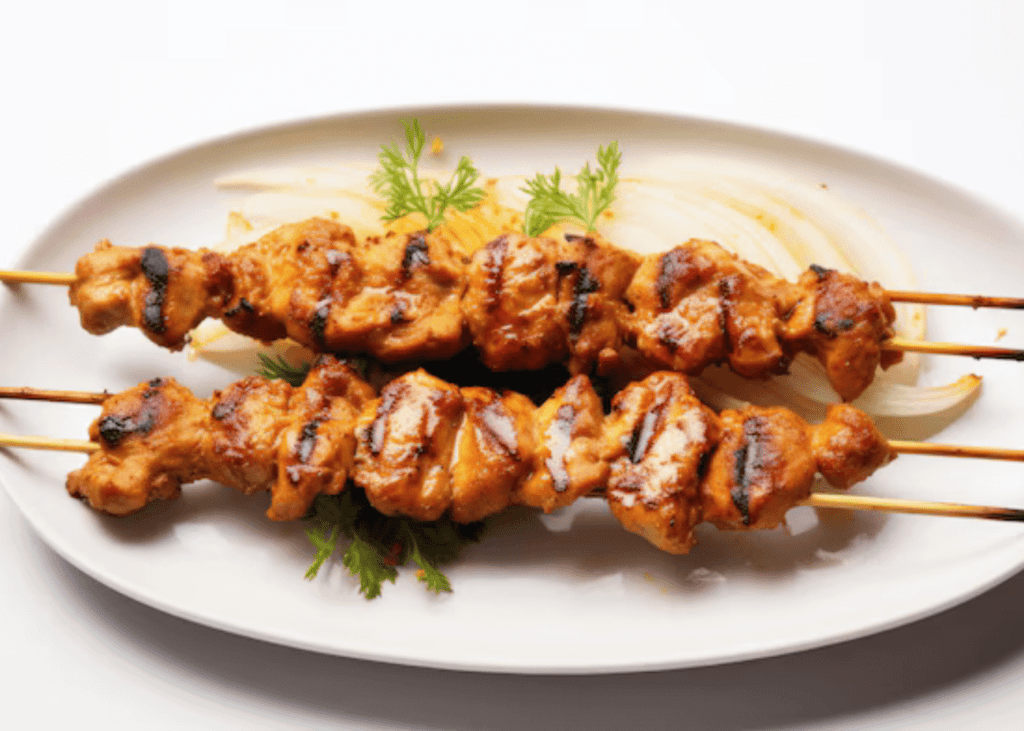
Satay is usually made with chicken or beef, but sometimes with lamb or rabbit. Spices like turmeric and garlic give the meat a wonderful flavor.
There was a special peanut sauce dip. This sauce is creamy and slightly sweet and goes well with the smoked meat.
I first tried Satay at the night market surrounded by friendly people and the sounds of cooking. It was excellent from the first bite.
So, if you are in Malaysia, you must try Satay. It’s not just food; That’s part of the place and its people. Grab a stick, dip it in peanut sauce, and enjoy!
#3. Char Kway Teow (Stir-Fried Noodles)
Char kway teow is a mixture of thin rice noodles in a hot wok with shrimp, bean sprouts, egg, chives, and a few key ingredients What makes it unique is the intense heat at which it is cooked, and gives the noodles a slightly smoky flavor, commonly referred to as “wok hei” or wok It calls it breath and this is what foodies rave about!
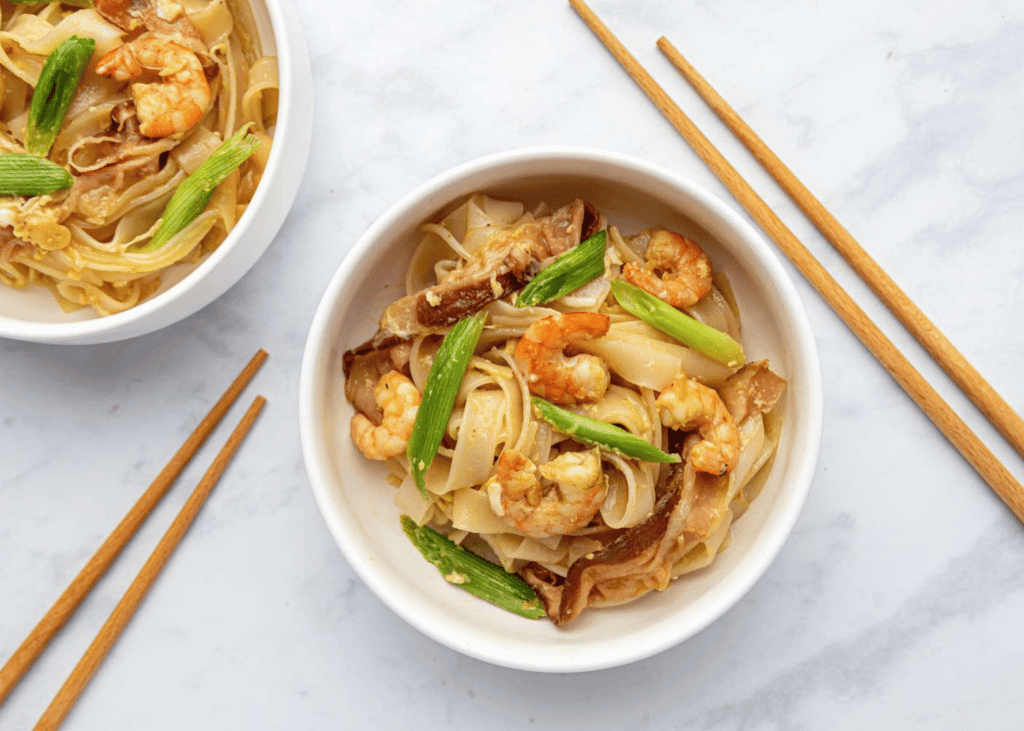
The noodles get their savory flavor from the combination of soy sauce and a little bit of chili, giving them flavor with just the right amount of kick. Most of the time, you get grilled Chinese sausage and sometimes fish cakes added to the mix for extra flavor and taste.
I first saw Char Kway Teow in a small restaurant in Penang, where it is particularly popular. The chef grilled the noodles with such skill that I knew I was in for a treat. After eating it on the spot, the buzz of the crowd around me made the noodles taste even better.
Whether you’re hungry after a day of exploring or in need of a quick satisfying meal, Char Kway Teow is the place to go. It’s fast, tasty, and captures the essence of Malaysian street food. Don’t miss this one — it’s a true flavor of Malaysian hot food!
#4. Laksa (Spicy Noodle Soup)
Laksha is a popular Malaysian noodle soup that comes in many flavors. Each of the spices and ingredients is different, but all laksas have a comforting and delicious taste.

The soup base can be rich and creamy with coconut or tart with tamarind. Laksha is usually chicken, fish, or shrimp and topped with fresh herbs like cilantro and mint. You may notice bean sprouts and tofu slices added to enhance the texture.
What really sets Lux apart is the perfume. The blend of Chilli, Turmeric, Garlic, and Lemon Grass gives it a unique and delicious taste.
Once, after a long day of exploring Kuala Lumpur, I tried a bowl of laksa in a small cafe. The first taste was amazing—spicy and creamy. It wasn’t just food; It felt like a special moment.
Laksa is great whether you need something comforting on a cold day or want to try a Malaysian specialty. Don’t miss this delicious treat. It’s a wonderful introduction to what makes Malaysian food so special.
#5. Roti Canai (Flaky Flatbread)
Roti canai is all about the texture. The dough is hand-stretched to be very thin and then folded into a circular shape to create layers. When cooked on a hot griddle, these layers puff up slightly, resulting in a bread that’s wonderfully flaky and tender.
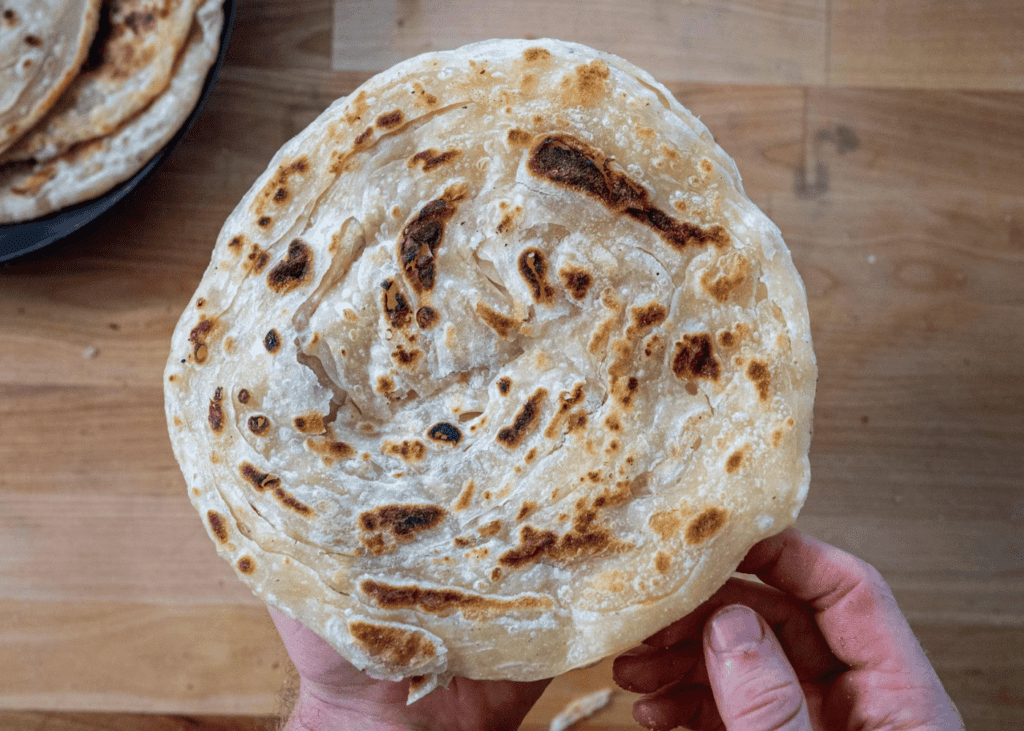
It’s often served warm with a side of dal or curry for dipping, which complements the mild, buttery flavor of the bread perfectly.
What’s captivating about roti canai is seeing it made right in front of you. Cooks flip and twirl the dough in the air like a pizza but with even more flair. Each flip makes the dough thinner and the final product lighter.
I first tried roti canai in a bustling morning market, drawn in by the smell of freshly cooked bread and the rhythmic sound of dough being worked on griddles. Eating it freshly made, with a cup of local coffee on the side, was an experience that stayed with me.
It’s simple yet satisfying and perfectly represents the heartwarming simplicity of Malaysian food.
No matter when you try it, roti canai is sure to delight. Its versatility and delicious taste make it a must-try for anyone visiting Malaysia. So, grab a piece, dip it in some curry, and enjoy the rich flavors and textures that Malaysian cuisine has to offer!
#6. Ikan Bakar (Perfectly Grilled Fish)
Ikan bakar, a beloved dish in Malaysia, where “ikan” means fish and “bakar” refers to grilling, is a simple yet cherished favorite along the coast.
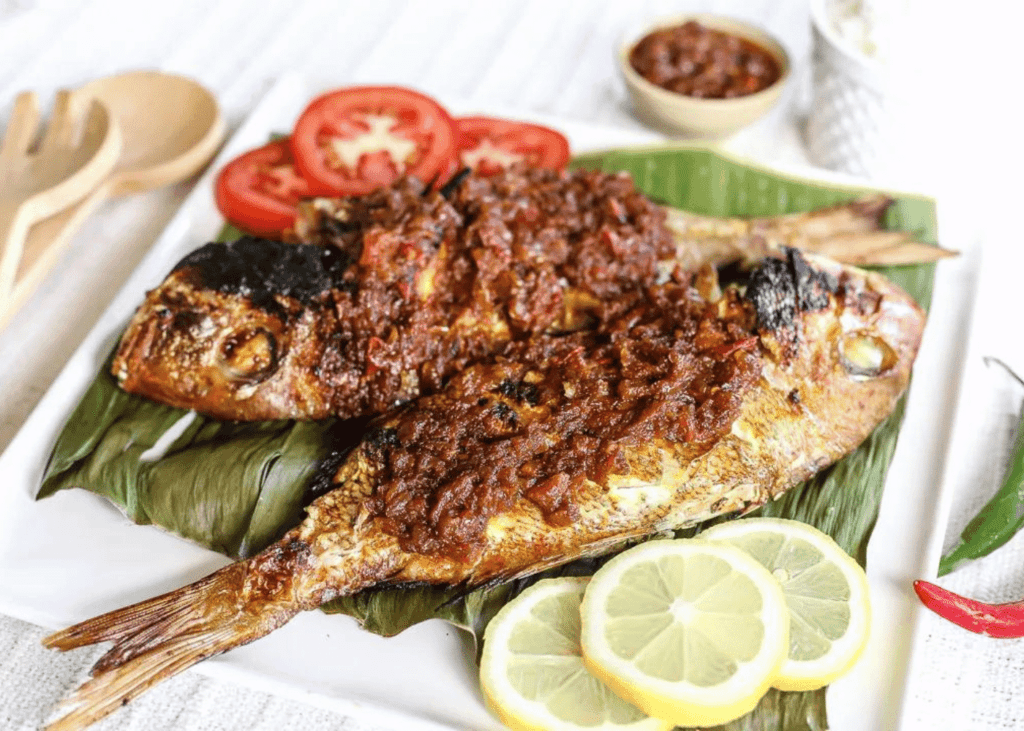
Ikan Bakar is a famous and delicious food in Malaysia that is marinated in a mix of spices including chili, turmeric, garlic, and shallots. It is full of strong, tasty flavors. It’s then wrapped in a banana leaf and grilled over charcoal.
The banana leaf keeps the fish moist while grilling over an open flame makes the fish sweet & smokey. It’s a great blend of flavors in every bite.
The first time I tried Ikan Bakar was next to a shopping mall on the beach. The smell of fried fish was amazing and delicious. It came with a squeeze of lime and some spicy sambal, making it unforgettable.
If you’re at a night market or beach restaurant, don’t miss the opportunity to try ikan bakar. It’s not just food; It is a great example of the Malaysian skill of grilling. Enjoy fresh and delicious flavors and the joy of eating something simple but well-made.
#7. Banana Leaf Meal (Dining Indian Style)
Banana leaf dish, a beloved Malaysian tradition that brings some Indian culinary culture right to your table.

Eating at Banana Leaf is an experience in itself. The big green leaf is your plate, not just for display—it’s believed to enhance the flavor of the dish. Meals usually begin with a leaf placed in front of you, its bright side shining under the lights.
Here’s how it works: hot steamed rice is served in the middle of the leaf, followed by a variety of colorful flavorful additions. These are usually a variety of vegetarian curries, pickles, and drops, sometimes meat or fish depending on location.
Completing the spread are crispy papadums and a dollop of chutney. But the real appeal of eating banana leaves lies in the way you eat them—traditionally, with your hands.
There is something so satisfying about mixing rice and curry with your fingers, feeling the texture and heat, and bringing every delicious bite into your mouth
#8. Nasi Kandar (Flavorful Fusion)
One of Malaysia’s favorite dishes, Nasi Kandar is a fusion of Malaysian cuisine, combining Indian spices with Malay cooking techniques.
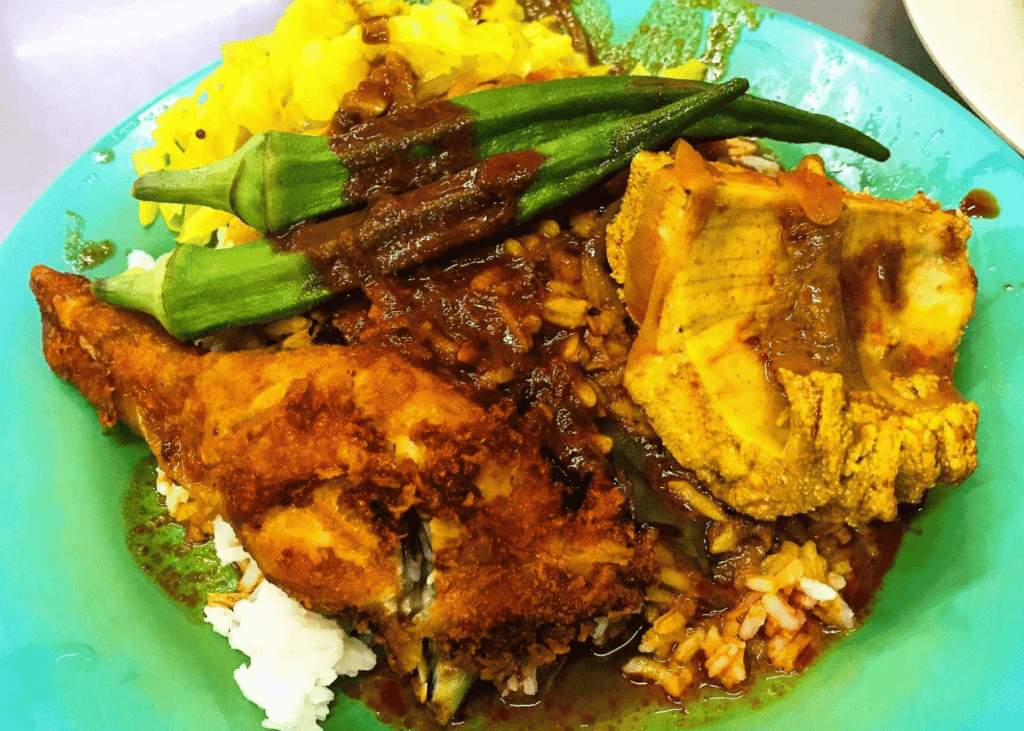
Nasi Kandar from Penang is a dish from Indian Muslim traders who carry their food on their shoulders. It consists of fried rice with curry sides.
Nasi Kandar is an aromatic rice dish that usually consists of meat and seafood curries, vegetables, and sometimes hard-boiled potatoes or seafood, each a bold and delicious combination of spices.
The specialty of Nasi Kandar is ‘Kuah Campur’ which blends various curries over rice to create a deep aromatic sauce that complements the flavors of the dish it is meant to flavor
I remember eating nasi Kandar for the first time in a busy Penang restaurant, surrounded by chattering diners. The flavors—from beef curry squid to spicy fish curry—were exceptional. Every bite was a burst of delicious spicy joy.
Nasi Kandar is more than food—it’s an exploration of Malaysian delicacies. For anyone who loves spicy curries, Nasi Kandar offers a culinary experience that is as delightful as it is satisfying.
#9. Hokkien Mee (Noodles)
Hokkien Mee is thick red noodles cooked in an aromatic sauce made with soy sauce and pork or chicken. It includes a mixture of pork, shrimp, and squid, all of which enhance the flavors of the dish.
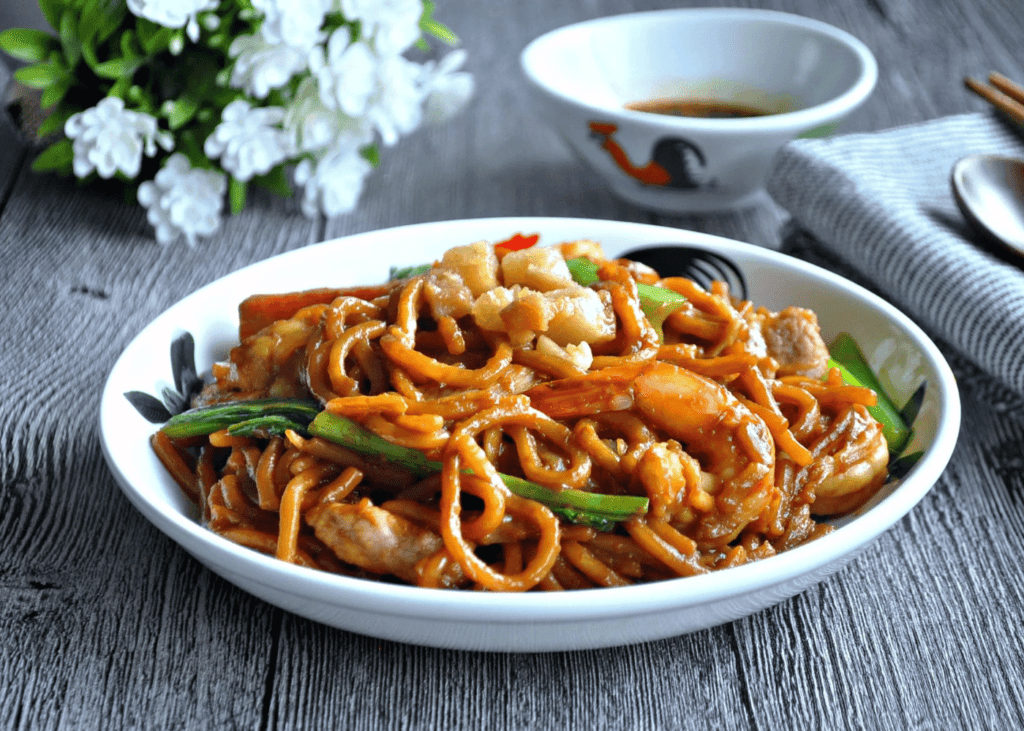
As the noodles cook, it forms a rich sauce, which makes every bite very tasty. This dish is usually topped with crispy vegetables and shallots, sometimes with spicy sambal for a touch of heat.
The unique part of making Hokkien mee is how the noodles are simmered in the stock until they are quite tender but still a bit tender. This cooking method adds thickness and deep flavor to the noodles.
The combination of soy sauce and seafood, along with a hint of smokiness from the wok, makes this dish satisfying any time of the day.
I got my first taste of Hokkien one cold evening at a busy street food stall in Kuala Lumpur. The aroma from the wok drew people in, and it was amazing to watch the chef skillfully mix the noodles and ingredients.
My first taste was so rich and comforting, it was like receiving a warm kiss in a bowl of noodles. Its strong flavor and essential ingredients make it a satisfying one that is sure to please.
#10. Hainanese chicken rice
Hainanese chicken rice is a favorite in Malaysia for its simple yet delicious taste. This dish originates from Hainan, China but has become a Malaysian favorite.
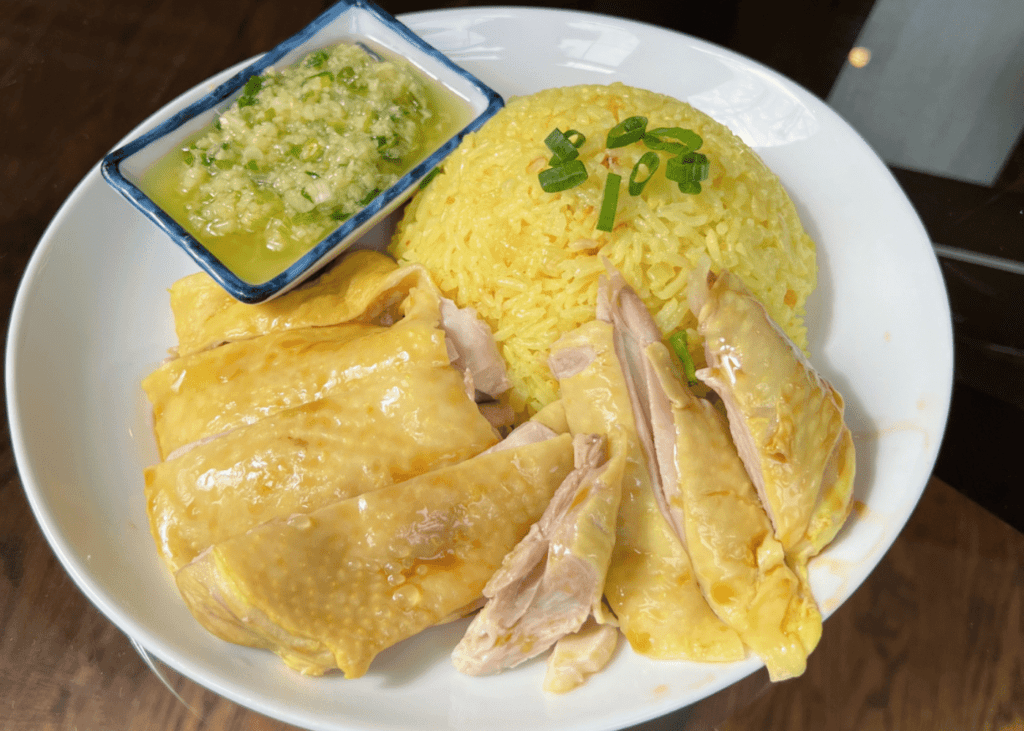
Hainanese chicken rice is very simple. It is chicken cooked until tender, cooked in chicken broth, and served with rice. The chicken is well-cooked to a tender and juicy texture. The rice is also unique; It is cooked with ginger and garlic, which adds flavor.
The best part of this dish is the accompanying sauces—mostly spicy chili sauce, sweet soy sauce, and ginger paste. These sauces allow you to mix and match flavors as you please.
I first tried this dish in Melaka, where a local told me it was a must-try. He was right. Fluffy chicken with rich rice and those sauces made it unforgettable. It is comforting food but also fun to eat because of all the flavors.
If you are in Malaysia, you must try Hainanese chicken rice. It’s a simple dish, but it’s so well prepared that it stands out. It’s a great way to see how something so straightforward can taste.
Top Restaurants for Authentic Malaysian Cuisine
Here’s a list of some of the top restaurants that offer authentic Malaysian flavors, right in the heart of Malaysia, particularly in Kuala Lumpur.
- DE.WAN 1958 – This restaurant offers a modern take on traditional Malaysian dishes. It’s a great place to experience refined versions of classic flavors.
- BETA – Located in Kuala Lumpur, BETA presents Malaysian cuisine in a contemporary and elegant setting. The dishes here are crafted to tell the story of Malaysia’s regional ingredients.
- DUSUN OPEN HOUSE – Celebrating the diversity of Malaysian food, this restaurant brings local ingredients to the forefront, providing diners with a truly Malaysian dining experience.
- ATAS – This upscale restaurant is known for its innovative approach to Malaysian cuisine, focusing on artisanal produce and exquisite presentation.
These restaurants are just a starting point for anyone looking to dive deep into Malaysian cuisine. Each offers a unique dining experience that highlights the rich culinary traditions of Malaysia.
Whether you’re a local or a traveler, these establishments provide a memorable and delicious way to explore the flavors of Malaysia.
Final Thoughts on Why Malaysian Food is The Best
As we wrap up our journey through Malaysian cuisine, we’ve seen how rich and varied it is. From the hearty nasi lemak to the savory Hokkien mee, each dish shares a piece of Malaysia’s cultural heritage.
Malaysian food offers everything from quick street food snacks to sophisticated meals at top-notch restaurants. Whether you’re enjoying a stay on the street or sitting down for a fine Ikan bakar, the diverse flavors reflect the country’s multicultural background.
Malaysia is a foodie’s paradise, full of delicacies just waiting to be discovered. Every meal offers an opportunity to explore the core of Malaysian culture.
So if you’re a food lover or just curious about different cuisines, make sure to try Malaysian food. It’s a delicious way to connect with the culture and history of this vibrant country.
FAQs Related to Malaysian Food
What are the most common ingredients in Malaysian cuisine?
Malaysian cuisine often uses ingredients like coconut milk, lemongrass, kaffir lime leaves, turmeric, and chili. These ingredients provide the distinctive flavors that make Malaysian dishes unique.
Is Malaysian food very spicy?
Malaysian food can be spicy, but it varies. Many dishes have a spicy kick, but there are also plenty of milder options. Restaurants usually can adjust the spice level to suit your taste.
Can I find good vegetarian options in Malaysian cuisine?
Yes, there are many vegetarian options in Malaysian cuisine. Dishes like vegetable curry, roti canai, and various tofu and tempeh preparations offer delicious vegetarian choices.
What is a typical Malaysian breakfast?
A typical Malaysian breakfast might include nasi lemak (coconut milk rice served with anchovies, peanuts, boiled egg, and spicy sambal), or roti canai (a type of flatbread served with dal or curry).
Are there any unique desserts I should try in Malaysia?
Definitely! Don’t miss out on desserts like cendol (a shaved ice dessert with coconut milk, jelly noodles, and palm sugar), and kuih (traditional Malaysian cakes and pastries made from rice or tapioca flour).

